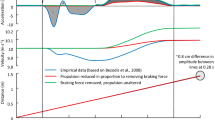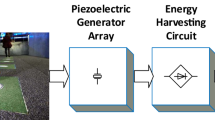Abstract.
In this paper, a newly proposed surface ropeway named “Circulating Cable Supported up down Walking Technology by Using Gravity” (CASWAT-G) is presented. CASWAT-G is facilitated by the gravitational force of the descending person, functioning as a gravitational energy harvester. At gravity balance, the ascending and descending persons apply very mild leg muscle forces for easy upwards and downwards walking while using it. Its working principle is close to the one of funicular and ski lift systems. Its working principles with the respective theory are presented to explain the way CASWAT-G functions. Experimental model data showed that a significant amount of harvested gravitational force from the descending person was utilized by the ascending person. The efficiency of the system was found to be above 80%, meaning that its performance is good enough to be used as a transportation facility in mountainous areas of developing countries, like Nepal. It could help not only to protect the environment and save energy but also to promote the livelihood and sustainable development of developing countries, especially in mountainous areas. In addition, it can be used to supply daily required goods to these areas and to promote local products and tourism.
Similar content being viewed by others
References
R.B. Singh, Practical Action, Gravity Goods Ropeway in Nepal (2013) https://practicalaction.org/blog/where-we-work/nepal/gravity-goods-ropeway-in-nepal/comment-page-1
United Nations Environment Programme, Nepal: state of the environment 2001 (United Nations Environment Programme, Khlong Luang, Thailand, 2001) http://www.rrcap.ait.asia/Publications/nepal%20soe.pdf
Ministry of Population and Environment, Nepal's State of the Environment (His Majesty's Government, Ministry of Population and Environment, Kathmandu, Nepal, 2000) http://www.mope.gov.np/download/State_of_Environment_of_Nepal_2000.pdf.6adc975d254c7c941ca8031b7bc04e03
R. Karkee, S. Khadka, S. Gautam, Int. J. Sci. Technol. 4, 412 (2015)
K.N. Poudyal, Estimation of Global Radiation in Nepal, PhD Dissertation (Institute of Engineering, Kathmandu, Nepal, 2015)
Water and Energy Commission Secretariat, Energy Sector Synopsis Report 2010 (Water and Energy Commission Secretariat, Kathmandu, Nepal, 2010) http://www.wecs.gov.np/uploaded/snyopsis.pdf
K. Hoffmann, FME Trans. 34, 205 (2006)
K. Hoffmann, FME Trans. 37, 175 (2009)
K. Hoffmann, Proceedings of MHCL'12, Belgrade, 2012, edited by S. Bošnjak, G. Kartnig, N. Zrni (University of Belgrade, Faculty of Mechanical Engineering, Belgrade, 2012)
Ropeway and Cable Car Pvt. Ltd., Past History of Ropeway in Nepal (2018) http://www.ropewaycablecar.com/about-us/past-history-of-ropeway-in-nepal
Hada, Gravity goods ropeways of Nepal: A case study (Nepal, 2009)
P. Parikh, A. Lamb, Trade and mobility on the rooftop of the world: Gravity ropeways in Nepal (Global Dimension in Engineering Education, Barcelona, Spain, 2015) http://hdl.handle.net/2117/89136
L.B. Baral, Proceedings of the 2010 International Conference on Chemistry and Chemical Engineering, Kyoto, 2010 (IEEE Xplore Digital Library, 2010) https://doi.org/10.1109/ICCCENG.2010.5560373
G. Morrill, Riding a poma lift (2010) http://retro-skiing.com/wp-content/uploads/2010/12/poma3300x229.jpg
L.B. Baral, J.J. Nakarmi, K.N. Poudyal, Molung Educ. Front. 6, 74 (2016)
L.A.J. Fartaria, Energy systems for transportation technologies, MSc Thesis (University of Technology, Vienna, Austria, 2011) https://ria.ua.pt/bitstream/10773/8726/1/5901.pdf
D. Astigaraga, Personal transportation system for underdeveloped hilly countries, B.Sc. Thesis (University of Technology, Vienna, Austria, 2011)
C.R. Nave, Hyper Physics: Gravitational Potential Energy (Department of Physics and Astronomy, Georgia State University, Atlanta, USA, 2016) http://hyperphysics.phy-astr.gsu.edu/hbase/gpot.html
L.B. Baral, J.J. Nakarmi, K.N. Poudyal, Res. J. Phys. Sci. 5, 1 (2017)
Author information
Authors and Affiliations
Corresponding author
Additional information
Publisher's Note
The EPJ Publishers remain neutral with regard to jurisdictional claims in published maps and institutional affiliations.
Rights and permissions
About this article
Cite this article
Baral, L.B., Nakarmi, J.J., Poudyal, K.N. et al. Gravity and muscle force operated surface ropeway: an efficient, cheap, and eco-friendly transport mode for mountainous countries. Eur. Phys. J. Plus 134, 55 (2019). https://doi.org/10.1140/epjp/i2019-12438-0
Received:
Accepted:
Published:
DOI: https://doi.org/10.1140/epjp/i2019-12438-0




